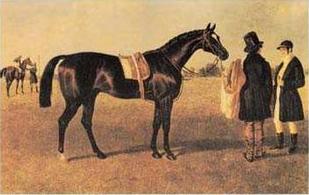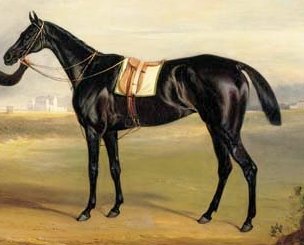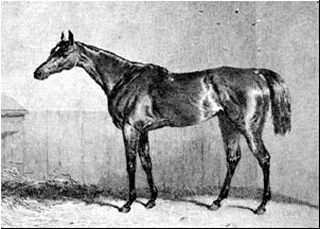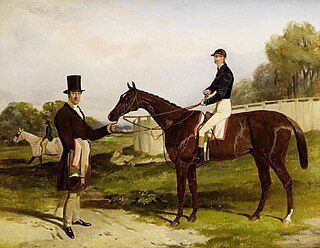Major wins
- 1,000 Guineas Stakes - Cara (1839)
- Epsom Derby - Phosphorus (1837)
- Epsom Oaks - Variation (1830)
| George Edwards | |
|---|---|
| Occupation | Jockey, Trainer |
| Major racing wins | |
| Major races 1,000 Guineas Stakes (1839) Epsom Derby (1837) Epsom Oaks (1830) | |
| Significant horses | |
| Cara, Phosphorus, Variation | |
George Edwards (1805-1851) was a British classic winning jockey in the 1830s.
Edwards was the son of trainer James "Tiny" Edwards, and brother of jockeys Edward and Harry. He was a strong jockey, and used this physicality to win races, [1] though he was not as skilled a rider as his brother Harry Edwards. [2]
Early success came in the 1825 Goodwood Cup aboard Cricketer and the same year's Goodwood Stakes on Stumps, before his first classic win in the 1830 Oaks on Variation. His greatest success came in the 1837 Derby on Phosphorus, who, because he had been lame prior to the race, started a 40/1 outsider. Edwards also won the 1839 1,000 Guineas on Cara, emulating his brother Edward's success from the previous year.
After retiring from riding, stud manager to the Duke of Orleans Count Cambis appointed him to train the Duke's horses. [3] At a Goodwood stable sale, he bought a horse called Beggarman for £500 and trained him up for the Duke to win the 1840 Goodwood Cup. This partnership partly began to break the dominance of Lord Seymour over the big French stakes races. [3] Further success as a trainer seemed assured, until the Duke was thrown from his carriage and killed. Edwards was immediately evicted and despite being given the occasional ride by General Peel, his career never recovered. [2]
George Edwards died impoverished in a Newmarket workhouse in 1851. [2]

Elnathan "Nat" Flatman, born Holton St. Mary, Suffolk, was the first Champion flat racing jockey of Great Britain. He began his thirty-four-year racing career as an apprentice jockey at age fifteen and by 1840 he was the dominant rider in British racing, winning the Champion Jockey title thirteen years in a row. During his career, Flatman won the patronage of many significant owners, including Lord George Bentinck, the Earl of Chesterfield, Admiral Rous, Lord Stradbroke and Lord Derby. For these owners, and others like them he won most of the important Thoroughbred horse races in England, including ten Classics, and some significant races in France. He continued to ride until the paddock accident that incapacitated him and ultimately led to his death at the age of 50.
Geoff Wragg was a Thoroughbred horse trainer who trained champion horses such as Teenoso and Pentire. He was the son of former jockey and trainer Harry Wragg, from whom he took over the licence at Abington Place, Newmarket in 1983 upon his father's retirement. Wragg retired in 2008 after 25 years of training and sold Abington Place to Sheikh Mohammed bin Khalifa Al Maktoum the following spring. He relocated to Yorkshire, the birthplace of his late father, Harry Wragg. He died in 2017.

The Flying Dutchman (1846–1870) was an English Thoroughbred racehorse and sire. He raced for four seasons between 1848 and 1851, winning all but one of his fifteen races, including The Derby and the St Leger. On his final racecourse appearance he defeated Voltigeur in what was probably the most celebrated match race in the history of British thoroughbred racing, known as The Great Match. He went on to be a success at stud both in Britain and France, where he died in 1870. The Flying Dutchman was regarded by experts as one of the greatest British racehorses of the nineteenth century.

Bay Middleton was an undefeated Thoroughbred racehorse whose victories included two British Classic Races. He was twice the Leading sire in Great Britain and Ireland.
John Scott (1794–1871) was a leading horse trainer in British Thoroughbred racing during the 19th century. Known as "The Wizard of the North," he was a brother to the successful jockey Bill Scott.

Touchstone was a British bred Thoroughbred racehorse and a leading sire in Great Britain and Ireland on four occasions. He was owned and bred by Robert Grosvenor, 1st Marquess of Westminster who bought him for the cheap price, at the time, of only 600 guineas at the insistence of his chief stud groom Mr. Thomas Nutting.

Surplice (1845–1871) was a British Thoroughbred racehorse and sire. In a career that lasted from July 1847 to October 1849 he ran thirteen times and won nine races. He was the leading colt of his generation in England at both two and three years old, with his wins including The Derby and the St Leger in 1848: he was the first horse for forty-eight years to win both of these Classics. His later career was less successful and he was retired to stud in 1850. Surplice had limited success as a sire of winners and died in 1871.

Phosphorus was a British Thoroughbred racehorse and sire. In his British career he ran three times and won two races. His most significant win came when he overcame a leg injury to win the 1837 Epsom Derby. Phosphorus was later sold and exported to Brunswick, but was unable to reproduce his English form. He was unsuccessful as a stallion.

St. Giles was a British Thoroughbred racehorse and sire. In a career that lasted from October 1831 to July 1835 he ran eleven times and won five races. After showing little form as a two-year-old, he made marked improvement to win his first three races of 1832, culminating with a highly-controversial success in The Derby. His only subsequent wins came in two minor races in 1835 and he was eventually sold and exported to stand as a stallion in the United States.

Priam (1827–1847) was a British Thoroughbred racehorse and sire. In a career that lasted from April 1830 to July 1832 he ran nineteen times and won seventeen races, including four walkovers. Unraced as a two-year-old he won seven of his eight starts in 1830 most notably The Derby. He continued to win major races, including successive runnings of the Goodwood Cup for the next two seasons before being retired to stud. He proved to be a successful sire of winners in both Britain and the United States. Priam was regarded by experts as one of the best horses to have raced in England up to that time.

Mameluke was a British Thoroughbred racehorse and sire. In a career that lasted from April 1827 to October 1829 he ran thirteen times and won seven races. Unraced as a two-year-old, he proved himself to be one of the best colts of his generation in 1827 when he won The Derby and finished second in the St Leger. Both races were surrounded by allegations of race-fixing and corruption. Mameluke raced with some success at four and five before retiring to stud. He was not a great success as a stallion.

Pussy was a Thoroughbred racehorse that won the 1834 Epsom Oaks. In a racing career that lasted from 1833 until 1837, Pussy started 25 times winning eight races. She initially raced under Thomas Cosby's name and was sold in 1835 to Lord Bentinck but raced under the Duke of Richmond's name. Pussy was retired to Bentinck's stud in 1837 but did not produce any noteworthy offspring. She was sold at auction in 1846, and her last foal was born in 1848.

Oxygen was a British Thoroughbred racehorse and broodmare who won the classic Oaks Stakes at Epsom Downs Racecourse in 1831. In a racing career which lasted from July 1830 until April 1833 she won eight of her fifteen races and finished second on five occasions. Oxygen's Oaks was the last of twenty classic wins for her owner George FitzRoy, 4th Duke of Grafton.

Cobweb (1821–1848) was an undefeated British Thoroughbred racehorse and who won two British Classic Races as a three-year-old and went on to become a highly successful broodmare. Cobweb's racing career consisted of three competitive races in the early part of 1824. After winning on her debut she claimed a second prize when her opponents were withdrawn by their owners. She then won the 1000 Guineas at Newmarket Racecourse and the Oaks Stakes at Epsom Downs Racecourse before being retired to stud.
Chapeau d'Espagne was a British Thoroughbred racehorse and broodmare who won the classic 1000 Guineas at Newmarket Racecourse in 1837. Chapeau d'Espagne was one of the best two-year-old fillies of 1836, when she won the Criterion Stakes and was placed in both the Molecomb Stakes and the Clearwell Stakes. In the following year she won the 1000 Guineas and finished second in the Oaks Stakes. After failing to win again in 1837 she returned as a four-year-old to win four more races. In all she ran twenty-two times between July 1836 and October 1838, winning eight races. After her retirement from racing she had some success as a broodmare.
Variation (1827–1847) was a British Thoroughbred racehorse and broodmare who won the classic Oaks Stakes at Epsom Downs Racecourse in 1830. The Oaks was Variation's racing debut and she went on to win a total of eight races from fifteen starts. Her other successes included three match races, the Oatlands Stakes, and two editions of the Garden Stakes at Newmarket Racecourse. Her best performance was probably her win in the 1831 Garden Stakes in which she defeated a very strong field over a distance of two miles. She was retired from racing in 1833 and had some success as a broodmare.

Mango was a British Thoroughbred racehorse and sire best known for winning the classic St Leger Stakes in 1837. He won nine of his thirteen races in a racing career which lasted from October 1836 until October 1838. Mango was well-beaten in his only race as a two-year-old and finished unplaced in The Derby but won three races at Royal Ascot in June. In September he won an exceptionally rough race for the St Leger at Doncaster Racecourse and then won the Newmarket equivalent a month later. Mango won twice in the following year, but became increasingly temperamental and difficult to manage. He was retired to stud at the end of 1838 but proved a failure as a sire.
George Dockeray (1789–1857) was a British jockey and racehorse trainer.

Frank Butler (1817-1856) was an English jockey who became one of the country's top riders. In a period of about 11 years he won The Derby twice, The Oaks on six occasions, the Two Thousand Guineas twice, the One Thousand Guineas twice, the St Leger, the Goodwood Cup on three occasions and the Triple Crown on West Australian. In his final years of racing he won 143 races from 384 starts. Illness forced him to stop riding in 1854 and he died two years later at the age of 39.
Alfred Day was a British classic winning jockey. He won seven classics between 1849 and 1859, including the Derby on Andover, and was nicknamed "King Alfred" for his success.